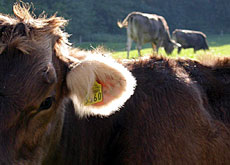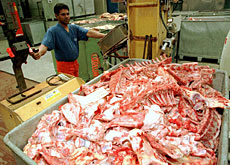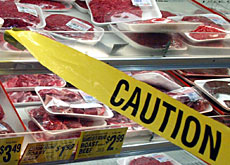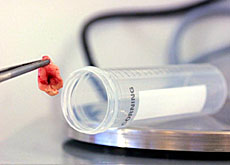Tide turns in battle against BSE

The number of cases of mad cow disease in Switzerland has dropped significantly in the past year, from 21 to just four, but the disease has yet to be eradicated.
The Federal Veterinary Office attributed the decrease to preventive measures taken since the first case was recorded in 1990.
But the office’s director warned that Switzerland was not yet free of mad cow disease. “We can still expect to see cows infected by bovine spongiform encephalopathy (BSE),” said Hans Wyss in Bern on Friday.
According to the Veterinary Office, the number of BSE infections started to drop between four and five years ago.
But because the disease has an incubation period of about five years, the decline has only recently started to show up in the statistics.
Until 2000, it was still possible for a cow to be infected by BSE, and one animal born that year later developed the disease.
Feed ban
The first case of BSE in continental Europe was reported in Switzerland in 1990.
At the time scientists thought the most likely cause was cattle feed prepared from bovine tissue such as brain and spinal cord, which was contaminated by the BSE agent.
The Swiss government introduced various measures over the years to prevent the spread of the disease to humans and the infection of other animals, but a complete ban on animal products in feed was only introduced in 2001.
The Veterinary Office says that it does not know if the feed ban will prove decisive in eradicating BSE, but no cows born after 2001 have developed the disease.
Brain and spinal cord tissue from slaughtered animals has been incinerated since 1996.
During the BSE scare in the mid-1990s, meat sales in Switzerland plummeted. According to the Federal Veterinary Office, the disease reached a peak in 1995 when nearly 70 cases were reported across the country.
In 2001, meat sales dropped by about ten per cent following a new outbreak of BSE in France, prompting a total ban on feed containing animal tissue.
Compensation
Earlier this year, an appeals commission found in favour of farmers who – in a claim dating back to 1997 – accused the government of failing to implement the ban between 1988 and 1990.
The commission said the government at the time acted “illegally” in favour of feed producers rather than the public interest and was liable for losses suffered by the country’s farmers during the mad cow disease crisis.
More than 2,200 farmers are demanding SFr300 million ($258million) in damages.
Migros, Switzerland’s biggest retailer, announced recently it would no longer test animals for BSE, ending a practice it introduced in 2001 for cattle older than 20 months. Migros main competitor, Coop, started testing animals at the same time.
Wyss said these systematic tests – 150,000 this year alone – were of little value, since BSE could only be detected in animals in the advanced stages of the disease.
swissinfo with agencies
First recorded case of BSE in Europe: 1986 in Britain.
First Swiss case: 1990.
The Federal Veterinary Office introduces fast BSE test in 1999 to monitor cattle.
A complete ban on meat and bone meal in feed for Swiss livestock is introduced in 2001.

In compliance with the JTI standards
More: SWI swissinfo.ch certified by the Journalism Trust Initiative



You can find an overview of ongoing debates with our journalists here. Please join us!
If you want to start a conversation about a topic raised in this article or want to report factual errors, email us at english@swissinfo.ch.